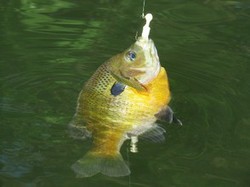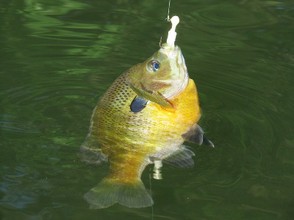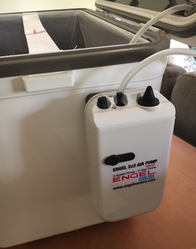
Freshwater Fishing Basics
This article provides basic information about freshwater fishing in North America.
Fishing Tackle Basics
Rods, Reels, Tackle, Etc.
Beginner fishermen (called "anglers") are faced with a staggering array of choices when it comes to choosing rods, reels, tackle, and other fishing equipment.
Although the reasons for so many variations are not usually apparent for beginners, much of the equipment that is available is very specialized and may not be suitable for all situations.
Before buying their first fishing outfit, the angler should consider a few factors:
Will fishing be done from shore or from a boat?
How deep will the water be where most fishing is done?
What species of fish will be primary targets?
How many times will the angler be fishing during the season?
Although beginner anglers may not have all these answers, it is still good to consider each question and think about what might lie ahead.
If the angler expects to do a considerable amount of fishing, it is usually well worth the effort to visit a local fishing tackle shop and seek advice.
Local shop owners are usually friendly, knowledgeable, and have a selection of gear that is appropriate for local fishing areas.
If a fishing tackle shop is not available locally, the angler must resort to visiting the sporting goods department of a local department store.
In either case, anglers will find several styles of rods, reels and other tackle. Most stores offer components separately, or as a pre-rigged combo package. For novices, a combo unit is often the best value.
Among the most popular are spinning rods and reels, equipped with monofilament line. Novices will notice that each reel will have a series of data conerning line capacity. These charts are confusing, but offer valuable information. Typically, a reel will accept several sizes of line, with the total amount depending on the line diameter. In other words, the thicker the line is, the less it takes to fill the reel.
For basic freshwater fishing, 8-12 pound test line is usually a good starting point. These lines are strong enough to be forgiving, but light enough to cast well. Heavier lines not only decrease casting distances but they are more likely to be seen by fish.
Bait fishing is a common technique for novice anglers. When fish are near the surface or at mid-depths, anglers will need only a basic bait such as nightcrawlers (worms), a few hooks and bobbers (floats). In other cases, fish can be caught by fishing on the bottom with a sinker and hooks or other setup.
Freshwater Fish Species
Depending on local conditions, freshwater anglers may encounter sunfish, bass, crappie, catfish, suckers, carp, perch, walleye, sauger, musky, pike, pickerel, trout, salmon, or other species.
For beginners, learning which species of fish are available locally is important. In most areas, species-specific regulations apply, so the angler must be able to identify fish accurately.
As anglers begin catching more and more fish, they quickly learn to recognize each species by shape, size, coloration, unique features or other methods.
After learning to identify species of fish and checking with local regulations, anglers usually decide if they will release all the fish they catch, or to harvest a few fish for food.
How often do you go freshwater fishing?
Freshwater Fishing Articles
Best Times to Go Freshwater Fishing
Time is one of the most important factors in fishing.
Summer Bluegill Fishing Techniques
Also known as bream, this colorful sunfish can be caught in a variety of habitats during summer.
You might also like
Engel Coolers For Fishing and Storing Live BaitSturdy Engel coolers for deep-sea fishing and keeping live bait at home or on...
Flat-lining for Yellowtail SnapperYellowtail Snapper are some of the tastiest fish in the ocean. Catching these...







 Harpers Ferry West Virginiaon 08/31/2015
Harpers Ferry West Virginiaon 08/31/2015
 How To Sell Foods at Farmers Marketson 06/04/2011
How To Sell Foods at Farmers Marketson 06/04/2011



Comments
Your list of commonest fishes -- bass, carp, catfish, crappie, musky, perch, pickerel, pike, salmon, sauger, sucker, sunfish, trout, walleye -- brought to mind an article that I read previously.
It's Why Is There Alaskan Salmon at Virginia Farmers Markets? by Stefanie Gans for Northern Virginia Magazine online Aug. 16, 2018.
The author lists bagels, coffee, cookies, croissants and cupcakes as commonest baked local goods. She mentions eggplant, nectarines, peaches and tomatoes as commonest fruits and vegetables.
Then Gans notes free-range eggs and pasture-raised chickens as well as Zac Culberston's Cold Country Salmon providing Alaskan salmon, black cod, halibut and Pacific rockfish because he's a producer who qualifies as farmer or staffperson selling their own grown/produced wares and whose office locates within 100 miles of farmers markets from Northern Virginia through Charlottesville.
In the recent past, I remember no fish at the farmer's and flea markets that I've been to. But that seems a great idea, at least in terms of local fish.
Would any of the farmer's and flea markets with which you're familiar be providing local fish? If so, which would be the most popular?
Reading and re-reading this wizzley always causes me to think of Icelandic author Ragnar Jónasson, whose books of course always bring in the fish for which Iceland is so famous.
His latest book, Outside (Úti), concerns a failed Icelandic rock ptarmigan hunt. Icelandic law is protective of the bird that becomes Christmas Eve dinner grouse. Hunters may lose fishing and shotgun licenses, pay fines and suffer up to two years' imprisonment. The legal system monitors fish and other animals.
Online sources most recently indicate that, here in the United States, Texas game wardens apprehended a central Texan who tried to sell area-lake game fish in April 2020.
Freshwater fishing seems like such an appealing activity that could be quite lucrative and such a fine public relations opportunity (tourism increases because fishing is safe and the fish all look and taste great) in the Harpers Ferry area.
Would there be any prohibition there -- understandable because of the importance of tourism and because of Southern States-wide tendencies to conserve and respect resources -- against catching fish that the fisher then tries to sell?
Regarding seasonal fishing, is Harpers Ferry an area for spring, summer and fall fishing predominantly? It seems to me that I heard or saw somewhere that the waters do not freeze sufficiently to support ice/winter fishing every year.
Would that be an accurate description? If so, about every how many years would there be ice/winter fishing opportunities in the Harpers Ferry area?
Your wizzley appears to apply to spring, summer and fall fishing, correct?
Winter fishing also gets my attention. (Have you read The Fisherman within The Angel on the Roof short-story collection by Russell Banks?)
Have you read the article Best Time of Day to Ice Fish: Morning Vs Evening, on the site FishTackly?
Jason gives the first two hours after sunrise and the first two hours before and after sunset because those are the times when fish eat phyto- and zoo-plankton, when fish need to worry least about predators seeing them and when fish see best!
The author, whose article is classified as an 11-minute read, also identifies Feb. 15 to March 15 as best winter months because of mating and spawning seasons.
Are you familiar with the article Fishing in Different Seasons that's available through the takemefishing site?
The article identifies early morning (6 a.m.-9 a.m.), late morning-early afternoon (9 a.m.-1 p.m.) and afternoon-early evening (1 p.m.- 5 p.m.) fishing times whose efficacy and enjoyment vary seasonally. It indicates afternoon-early evening, early morning and afternoon-early evening and only afternoon-early evening fishing times for spring, summer and fall, respectively. It mentions that the afternoon-early evening slot during the fall months as one of the year's all-time best fishing times!
Your observation that "For basic freshwater fishing, 8-12 pound test line is usually a good starting point. These lines are strong enough to be forgiving, but light enough to cast well. Heavier lines not only decrease casting distances but they are more likely to be seen by fish" caught my attention.
So I did an online search of what fish do and do not see from anglers.
Do you read what's on Northland Fishing Tackle? The site has an article, Do Fish See Line? The article indicates that fluorocarbon is the most invisible to fish underwater and that braided line and red and yellow colors are the most visible above water and underwater.
Thank you for the information!
Have you read "Single Hook Lures for Trout" online in Finesse-Fishing? That's what the article says, that bait can be injurious and that barbless single hooks are fish-friendlier.
This subject is often debated. Many fishermen that practice catch and release prefer lures with single barbless hooks. Bait can be problematic in some fisheries because fish tend to swallow it can there can be injury from the hook going too deep.
Revisiting your wizzley called to mind something that I've been considering lately.
Is bait the kindest, least fish-harming, most environmentally friendly way of catching and releasing? It seems to me that it could be, what with seeing that the catch is fed and then let go ;-D!
Most often we begin with a small spinning rod and reel with 6 or 8 pound test line and natural baits.